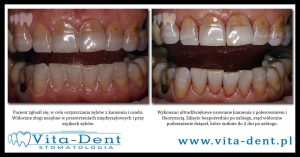Ultrasonic tartar removal
The second most common reason after caries is their mobility due to bone reduction due to the presence of plaque stone. The plaque consists of mineralized layers of plaque. Initially, its deposition on the teeth is asymptomatic, but as its size increases, it can cause many diseases m.in inflammation and bleeding of the gums, caries or loosening of teeth. To avoid this, it is necessary to thoroughly clean the teeth from the plaque and regularly remove the plaque in the dental office. We distinguish the stone above- and poddziąpruy. What is the course of treatment? Here is a simplified scheme:
Removal of supragingival calculus:
- First visit: The dental hygienist monitors the patient's oral hygiene by calculating the oral health indicators – API and PBI and comparing them with the previous visit. Then, using an ultrasonic scalper, removes the plaque. After its removal, it checks in dental magnifying glasses or under the microscope the accuracy of the procedure and if the stone is removed entirely then polishes the cleaned surfaces of the tooth neck. Because the places after the removed stone are demineralized by bacteria living in the stone, after each scaling it is advisable to carry out contact fluoridation of teeth in order to strengthen the enamel and reduce postoperative hypersensitivity. After treatment, dental hygienist discusses with the patient the places where the amount of stone was greatest in him and shows how to clean his teeth to avoid deposition of the plaque in the future.
Removal of sub-ginstone:
- First visit: before removing the stone, the dentist uses local anesthesia for a painless course of the procedure and then removes subgingival calculus using an ultrasonic scaler. After the procedure, he wears a gum dressing and prescribes appropriate mouth washable fluids. In the case of a very deeply placed tartar, it is sometimes necessary to add additional cleansing with hand tools. Gingival pockets in the area of the removed stone with a depth of more than 5mm are an indication for disinfection of the root surface using a laser – photoactive PAD disinfection, which significantly improves the prognosis of curing inflammation of the gums.
Faqs:
- Does descaling damage the enamel? – properly carried out scaling of tartar deposits is not harmful to tooth enamel.
- How often should I remove limescale? – The frequency of tartar removal depends on the level of oral hygiene, so an integral part of any visit to a dental hygienist is to discuss the state of oral hygiene and appropriate teeth cleaning instruction. Usually, the treatment for stone removal is carried out every 1~2 years..
- Is the descaling procedure painful? – this procedure thanks to the use of an ultrasonic tip is painless. After the procedure, the hypersensitivity of the teeth, which usually disappears during the day from the procedure, in order to reduce hypersensitivity after the procedure of hygienist can perform an additional procedure of contact fluoride of the teeth, which further strengthens the enamel of the teeth.

